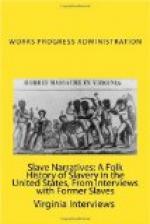“At the beginning of the Civil War I was still at this place as a slave. It looked at the first of the war as if the south would win, as most of the big battles were won by the South. This was because we slaves stayed at home and tended the farms and kept their families.
“To eliminate this solid support of the South, the Emancipation Act was passed, freeing all slaves. Most of the slaves were so ignorant they did not realize they were free. The planters knew this and as Kentucky never seceeded from the Union, they would send slaves into Kentucky from other states in the south and hire them out to plantations. For these reasons I did not realize that I was free untill 1864. I immediately resolved to run away and join the Union Army and so my brother and I went to Owensburg, Ky. and tried to join. My brother was taken, but I was refused as being too young. I [HW: tried] at Evansville, Terre Haute and Indianapolis but was unable to get in. I then tried to find work and was finally hired by a man at $7.00 a month. That was my first independent job. From then on I went from one job to another working as general laborer.
“I married at 24 years of age and had four children. My wife has been dead for 12 years and 8 months. Mr. Miller, always remember that:
“The brightest man, the prettiest
flower
May be cut down, and withered in
an hour.”
“Today, I am the only surviving member who helped organize the second Baptist Church here in Lafayette, 64 years ago. I’ve tried to live according to the way the Lord would wish, God Bless you.”
“The clock of Life is wound but
once.
Today is yours, tomorrow is not.
No one knows when the hands will
stop.”
Cecil Miller
Dist. #3
Tipp. Co. [TR: Tippecanoe Co.]
Negro folklore
Mr. John fields, ex-slave
2120 N. 20th St. Lafayette, Indiana
[Illustration: John W. Fields]
Mr. Fields says that all negro slaves were ardent believers in ghosts, supernatual powers, tokens and “signs.” The following story illustrates the point.
“A turkey gobbler had mysteriously disappeared from one of the neighboring plantations and the local slaves were accused of commeting the fowl to a boiling pot. A slave convicted of theft was punished severly. As all of the slaves denied any knowledge of the turkey’s whereabouts, they were instructed to make a search of the entire plantation.”
“On one part of the place there was a large peach orchard. At the time the trees were full of the green fruit. Under one of the trees there was a large cabinet or “safe” as they were called. One of the slaves accidently opened the safe and, Behold, there was Mr. Gobbler peacefully seated on a number of green peaches.
“The negro immediately ran back and notified his master of the discovery. The master returned to the orchard with the slave to find that the negro’s wild tale was true. A turkey gobbler sitting on a nest of green peaches. A bad omen.




